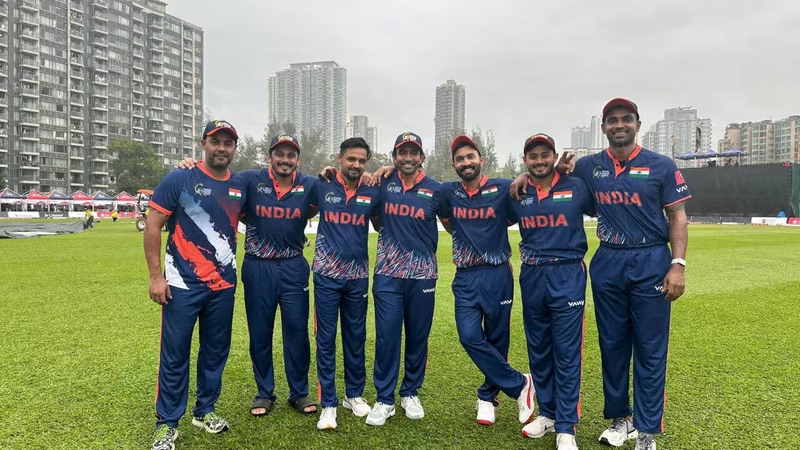In a stunning and humbling turn of events, India crashed out of the 2025 Hong Kong Sixes tournament without winning a single match in the main competition. Despite fielding a squad featuring veteran stars like Dinesh Karthik and pacer Abhimanyu Mithun, the Indian team suffered consecutive losses to Kuwait, the UAE, and Nepal—three sides not traditionally seen as cricketing powerhouses on the global stage .
The result marks one of the most unexpected early exits for India in a franchise-invitational event and raises questions about preparation, team composition, and the challenges of adapting to the high-octane Sixes format. While Pakistan and Australia stormed into the semifinals with dominant performances, India’s campaign fizzled out before it could gain momentum .
Table of Contents
- What Is the Hong Kong Sixes Format?
- India’s Results and Key Moments
- Why India Struggled: Tactical & Technical Breakdown
- Silver Linings: Dinesh Karthik and Mithun Shine
- The Rise of Associate Nations: What This Means for Global Cricket
- Summary
- Sources
What Is the Hong Kong Sixes Format?
Before dissecting India’s failure, it’s crucial to understand the unique nature of the Hong Kong Sixes. Unlike T20s, this invitational tournament features:
- 6-player teams (5 on field + 1 substitute)
- 5-over innings per side
- Max 2 overs per bowler
- Mandatory PowerPlay: First 3 overs with only 3 fielders outside the ring
- No LBW appeals unless batter offers no shot
This format rewards explosive batting, agile fielding, and versatile bowling—qualities that favor adaptable, athletic players over traditional specialists. As noted by the ICC’s feature on emerging cricket formats, Sixes tournaments are becoming testing grounds for innovation and athleticism in the sport .
India’s Results and Key Moments
India’s campaign unraveled across three tightly contested but ultimately lost matches:
- vs Kuwait: Chasing 98, India collapsed to 82/5. Poor shot selection in the death overs proved costly.
- vs UAE: Despite Karthik’s 32* off 18, India fell short by 6 runs due to a weak start (12/2 in first over).
- vs Nepal: Mithun took 2/12, but the batting lineup failed again, scoring just 79/6 while chasing 92.
With only the top two teams from each group advancing, India’s 0–3 record left them at the bottom of their pool—eliminated before the knockout stage even began .
Why India Struggled: Tactical & Technical Breakdown
Several factors contributed to India’s surprising downfall:
- Lack of Format Familiarity: Many Indian players had never played Sixes before. The ultra-short nature demands split-second decision-making—something veterans like Karthik adapted to better than others.
- Bowling in PowerPlay: With only 3 fielders allowed outside the circle for the first 3 overs, bowlers struggled to contain boundaries. India conceded an average of 9.4 runs per over in PowerPlays.
- Team Composition: The squad lacked pure power-hitters. While experienced, it wasn’t optimized for a format where every ball must count.
For a deeper look at how team composition affects short-format success, see our analysis on [INTERNAL_LINK:how-to-build-a-winning-sixes-squad].
Silver Linings: Dinesh Karthik and Mithun Shine
Amid the disappointment, there were standout performances. Dinesh Karthik, at 39, showed why he remains a finisher extraordinaire—scoring at a strike rate of 177 across matches and marshaling the lower order with calm authority .
Likewise, Abhimanyu Mithun adapted his line-and-length perfectly for the compact Hong Kong wicket, using slower balls and yorkers to great effect. His economy rate of 6.80 was among the best in the tournament .
The Rise of Associate Nations: What This Means for Global Cricket
Perhaps the biggest story isn’t India’s loss—but who beat them. Kuwait, UAE, and Nepal have invested heavily in short-format cricket, running domestic Sixes leagues and fast-tracking youth development. Their players are bred for these conditions.
This result underscores a growing trend: associate nations are no longer minnows. As the ESPNcricinfo report on associate cricket highlights, teams like Nepal and UAE now regularly outperform Full Members in exhibition and T20 events . India’s exit is a wake-up call for traditional powers to take emerging cricket seriously.
Summary
India’s early India Hong Kong Sixes exit is a stark reminder that cricket’s landscape is rapidly evolving. In a format designed for speed, innovation, and athleticism, experience alone isn’t enough. While Dinesh Karthik and Abhimanyu Mithun provided glimpses of class, the team’s overall lack of adaptation to the Sixes structure led to a shocking three-match whitewash by associate nations. For Indian cricket, this isn’t just a loss—it’s a lesson in humility and the need to embrace new formats with fresh thinking.
Sources
- Times of India: India crash out of Hong Kong Sixes after triple setback
- Hong Kong Cricket Association: Hong Kong Sixes 2025 Match Centre
- ICC Cricket: The Evolution of Short-Format Cricket: Beyond T20
- ESPNcricinfo: How Associate Nations Are Dominating Short-Format Cricket
